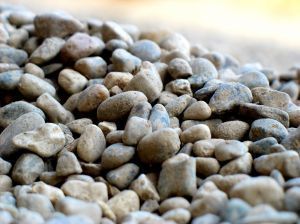Crushed Rock a Great Choice for Outdoor Projects
Updated: 2020-12-15
By Paul Bianchina
For a wide variety of outdoor projects, from paths and parking areas to weed and fire control, gravel and crushed rock can be just what you need to get the job done. There are a surprising number of options available, including many different sizes, colors and types of rock, so there's bound to be something out there that's just right for whatever area you want to cover.
Buying Gravel
Gravel and crushed rock is available in small bags at many home centers, and in bulk through rock and masonry dealers, landscaping suppliers, nurseries, concrete suppliers and other sources. Most bulk dealers have yards that are open to the public, so you can look at different types of gravel side by side and compare.
Other than in the small bags, which are convenient for very small projects but cumbersome and prohibitively expensive for larger jobs, gravel and crushed rock are sold by the cubic yard, often abbreviated to just "yard." One cubic yard is equal to the size of a cube 3 feet wide, 3 feet long, and 3 feet high, or 27 cubic feet. Since it's pretty unlikely that you're going to need gravel 3 feet thick, converting a cubic yard into actual coverage can be a little confusing. To simplify things, the following chart shows approximately how much area one cubic yard will cover at different depths:
* 160 square feet at 2 inches deep
* 108 square feet at 3 inches deep
* 80 square feet at 4 inches deep
* 54 square feet at 6 inches deep
If you have a truck or a trailer, you can haul the rock yourself - the dealer will load it for you - and save the cost of delivery. For larger loads, you're better off having the dealer just deliver it for you directly to your site. There is typically a small per-yard charge for delivery, which is often waived if you buy a large enough amount. If your site is accessible, most dealers will also drop the rock off the truck so that it spreads out, rather than just dumping it in a pile - an added benefit that can save you a considerable amount of shoveling and spreading by hand.
Types of Crushed Rock
While just about any crushed rock can be used for just about any non-structural application, some rocks are better choices then others for certain uses.
River rocks, for example, are rounded and smooth in appearance, with no sharp or pointed edges. They will tend to roll slightly underfoot and they don't pack down hard against one another, but they drain water very well. Common size ranges (based on the average diameter of the rock) include 3/8 inch - 1/2 inch, also called pea gravel; 1/2 inch - 1 inch; and 1 1/2 inch - 2 1/2 inch. Larger sizes are also available. Common uses include paths, landscaping, drainage areas, and some animal areas. Pea gravel is a common additive in decorative exposed aggregate concrete, and the good drainage qualities of larger river rock makes it a common choice for septic drain fields.
Crushed gray rock is the generic "gravel," and is more sharp and irregular on the edges. The sharper edges cause the individual pieces to interlock with one another, packing them down more firmly underfoot. Once common size of gravel is 0 - 3/4 inch, called "3/4 minus," which has rocks ranging from 3/4 of an inch down to powder. The powder, called "fines," fills in all the little areas between the larger rocks for good compaction, although it can be dusty to drive on until it gets a sufficient amount of water to settle everything into place. The other size is 1/4 inch - 3/4 inch, which packs well without as much dust, although the packing will take a little longer to occur. Common uses for both materials include roads, driveways, base rock for asphalt and concrete slabs, and paths and walkways.
You'll also find some regional differences in what types of rock is readily available. In some areas, lava rock is quite common, while in others you may find a wider selection of river rock. Colors can vary between regions as well, and different dealers may have access to crushed rock in sizes that other different from other dealers. Unless you know specifically what you want, it often pays to check out the selection offered by at least two dealers.
Comments (0)

